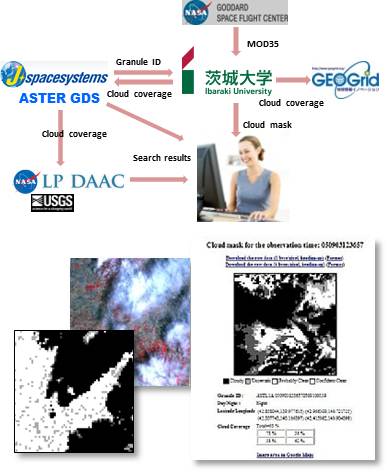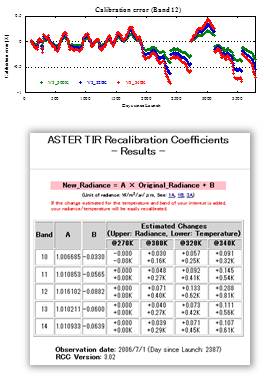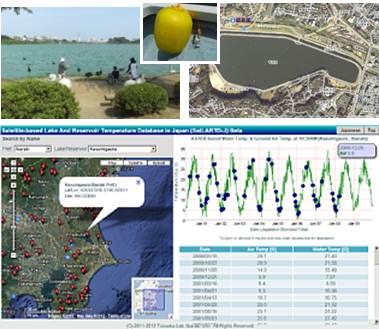ASTER Cloud Mask Database
Cloud assessment of satellite imagery is important for image search and higher-level processing. Unfortunately, the cloud assessment algorithm of ASTER is not accurate particularly for non-full-mode observations such as nighttime observation and V-only-mode observation, and also for all daytime observations after April 2008 when ASTER shortwave infrared bands stopped due to a trouble in their temperature control. Thus, we are generating more accurate cloud masks for all ASTER scenes over two million scenes and provide them here. All reassessment results are transferred to ASTER Ground Data System (GDS) and NASA’s LP DAAC (Land Processes Distributed Active Archive Center) every day, and then input to the database used for ASTER image search.
[Ref.] H. Tonooka, K. Omagari, H. Yamamoto, T. Tachikawa, M. Fujita, Z. Paitaer, ASTER cloud coverage reassessment using MODIS cloud mask products, Proc. of SPIE, vol. 7862, Oct. 2010.

ASTER/TIR Recalibration Coefficients
ASTER Thermal Infrared (TIR) radiance products include radiometric calibration errors caused by delay in radiometric calibration coefficients (RCC) updating. You can get recalibration coefficients which allows to reduce such errors. This work is introduced in ASTER Science Project web.
[Ref.] H. Tonooka, F. Sakuma, M. Kudoh, and K. Iwafune, ASTER/TIR onboard calibration status and user-based recalibration, Proc. SPIE, 5234, 191-201, 2003. [PDF]

Satellite-based Lake and Reservoir Temperature Database in Japan (SatLARTD-J) [Period: 2000 to 2013]
Water temperature is an important environmental factor for many lives in or around inland water bodies such as lakes and reservoirs, and is notable in the aspect of biodiversity. It is also reported that water temperatures of some lakes are increasing probably due to global warming. However, many lakes and reservoirs except for a part of large lakes have not continuously or never been monitored on water temperature. Thus, Tonooka Laboratory of Ibaraki University has been developing the Satellite-based Lake and Reservoir Temperature Database in Japan (SatLARTD-J) since 2009. Currently SatLARTD-J includes about 1000 lakes and reservoirs in Japan using Terra/ASTER data observed from 2000 to 2013. The database will be extended in the future.
[Ref.] H. Tonooka, and M. Hirayama, Development of Japanese inland water surface temperature database using ASTER thermal infrared imagery, Proc. of SPIE, vol. 8174, 81741A, Oct. 2011.
